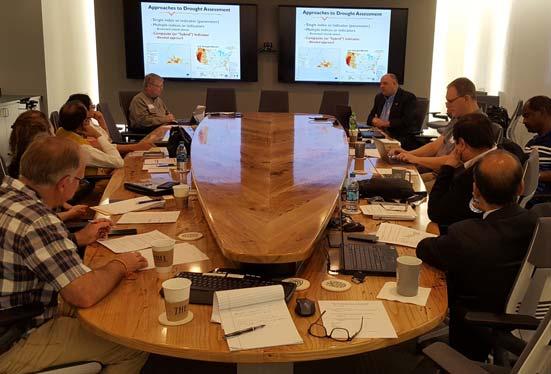
4 minute read
Monitoring Droughts
By HILLARY HOPPOCK
The Indian Agricultural Research Institute and the Daugherty Water for Food Global Institute at the University of Nebraska have developed an agricultural drought monitoring system for India.
Advertisement
Over the past 30 years, droughts have increasingly affected agricultural production and food security in various regions across the world. India, for instance, has experienced many weak seasonal monsoons over the past 20 years.
With the increase in India’s population, there has been a corresponding rise in the demand for food and water for agriculture. This, in turn, has led to depletion of aquifers, primarily due to expanding agricultural irrigation. “India has been looking for technological interventions to help build drought resilient agricultural systems,” says Ravinder Kaur, principal scientist at the Indian Agricultural Research Institute (IARI) for a collaborative U.S.-India research project through the United States-India Educational Foundation (USIEF). “We need to monitor droughts more efficiently and implement demand-driven irrigation schedules for our crops.”
She feels that the University of Nebraska Lincoln (UNL) was the logical choice for an exchange of scientists and researchers with IARI. Home to the National Drought Mitigation Center (NDMC), the university has extensive experience in drought monitoring in different regions of the world. “The Daugherty Water for Food Global Institute (DWFI) at the University of Nebraska uses the hybrid SETMI [spatial evapotranspiration modeling interface] model to apply the remotely sensed inputs for monitoring field- or catchment-scale crop water demands to develop effective crop-specific irrigation schedules,” says Kaur.

Ravinder Kaur (right) with Christopher Neale (third from left) at the Nebraska Unmanned Aircraft Integration Research and Education lab.
Courtesy Daugherty Water for Food Global Institute
In 2016, IARI and DWFI established a partnership, titled Improving Water Management, Agricultural Production and Food Security in Drought Prone Areas, funded by the U.S.-India 21st Century Knowledge Initiative. Christopher Neale, DWFI director of research and creator of the SETMI model, notes that the expertise of faculty and staff at both institutions contributed to meeting the project’s three main objectives of developing an agricultural drought monitoring and early warning system for India, providing satellite-based evapotranspiration estimates for irrigation system monitoring and developing water-conserving sensor-operated irrigation scheduling protocols.
“IARI students and our staff worked together on each of those objectives,” says Neale. “The Pan India Composite Drought Monitoring Index was developed through collaborative research of the Indian faculty, their Ph.D. students and the UNL faculty and staff at NDMC. In 2019, it was successfully tested in two of the most drought-prone regions of India—Karnataka and Maharashtra—and is now transferable to other regions.”
Water demand monitoring
According to Kaur, the current practice of flood irrigation, which sacrifices huge amounts of water for only 30 to 40 percent efficiency, needs to be replaced with targeted micro-irrigation that supplies the water to the roots of the plant for 80 to 90 percent efficiency. “However, though subsidized in India since 1980, micro-irrigation is currently being used on only 11 percent of agricultural land,” she says. “Efficient drought and irrigation water demand monitoring through satellite data, and its demand-based scheduling are the starting points for India to develop an efficient water management system.”
Indian faculty and two Indian Ph.D. students worked with DWFI for two years to accurately estimate the irrigation water needed for India’s winter wheat crop. The SETMI model was used on the Narmada canal project in Rajasthan to remotely sense the crop evapotranspiration across the irrigation project area. “Evapotranspiration,” explains Neale, “is the combined processes of evaporation from the soil surface and the transpiration of water vapor through the plant’s stomata, which are openings where carbon dioxide goes in and water vapor comes out. This evapotranspiration can be estimated using the thermal infrared band of a satellite sensor detecting the temperature from a water-stressed plant, even before it shows wilting or other physical signs of stress. And that combination of the visible and near-infrared satellite bands and a thermal infrared band allows for the modeling of crop consumptive use, irrigation timing and how much water to apply.”

Kickoff workshop for the collaborative U.S.-India research project on monitoring droughts and assessing crop water demand.
Courtesy Daugherty Water for Food Global Institute
IARI’s notable contribution to this program, according to Kaur, was fine-tuning the research processes and accomplishing field observations to validate the modified technology protocols for spatial drought and irrigation water demand monitoring in data- sparse and drought-prone areas. The research on the use of water-conserving sensors to operate irrigation scheduling protocols was also initiated and had encouraging preliminary results.
Pandemic intervenes
“The global COVID-19 pandemic has stymied the conclusion and final steps of this research project since March 2020, impacting the implementation of the project’s collaborative research results in India,” says Kaur. “The whole goal of the program was not to just publish papers, but to transfer and apply the technologies in India.” Workshops which were going to be held in New Delhi, to disseminate the project’s research results to policymakers, technical staff, and state and regional government officials, had to be canceled.
Kaur acknowledges that time is a big constraint right now. “This partnership has given us the building blocks for a satellite-based drought monitoring system, a catchment-scale crop water demand estimating system and crop temperature stress-based algorithms for sensing and automatically delivering irrigations,” she says. “But we need time to further validate the developed irrigation scheduling protocols on other crops and share the developed protocols for monitoring droughts and assessing crop water demand in larger irrigation operations with Indian policymakers and researchers, for it to translate to large-scale application and adoption.”
Hillary Hoppock is a freelance writer, former newspaper publisher and reporter based in Orinda, California.










